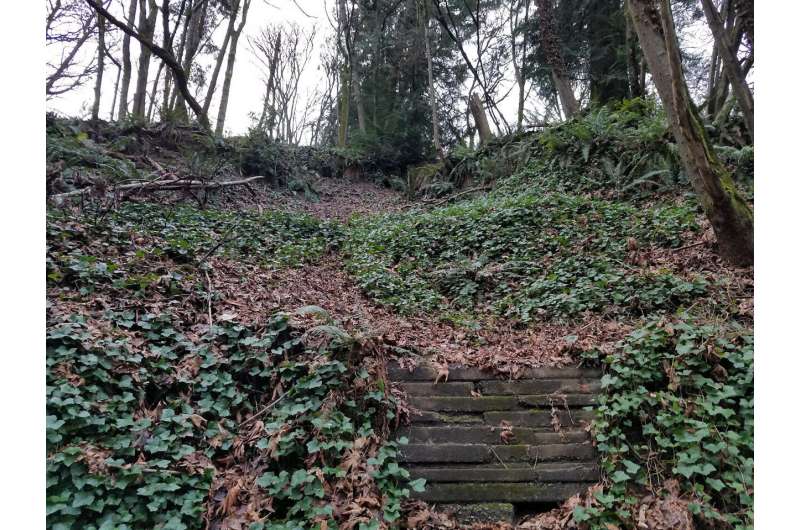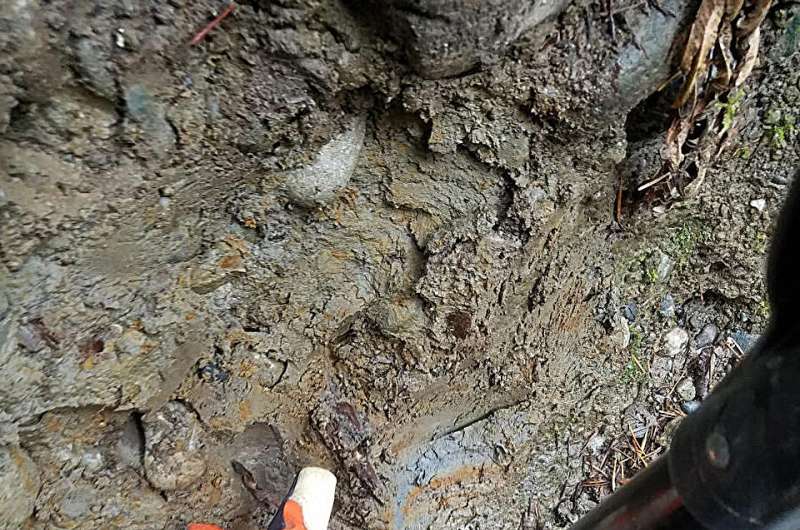This article has been reviewed according to Science X's editorial process and policies. Editors have highlighted the following attributes while ensuring the content's credibility:
fact-checked
peer-reviewed publication
trusted source
proofread
New date evidence for landslides reveals past Seattle fault earthquakes

New maps of more than 1,000 deep-seated landslides in the Puget Lowlands of Washington State provide evidence of the last major earthquake along the Seattle Fault about 1,100 years ago—and may also hold traces of older earthquakes along the fault.
Clusters of landslides offer a potential record of earthquakes, if researchers can determine when the landslides occurred. The new study published in the Bulletin of the Seismological Society of America combines information about the location of these Puget Lowlands landslides along with new dates obtained from measuring the surface roughness of the landslides.
The combination of data helped Erich Herzig of the University of Washington and colleagues uncover strong evidence of the last known major Seattle Fault earthquake, thought to be a magnitude 7 to 7.5 event. (A recent study suggested that there may have even been a double earthquake at the time in the region.)
The researchers compared their new landslide map to ground motions generated by different Seattle Fault earthquake scenarios. The scenario that best matches the landslide clusters, they found, is one that produces the strongest shaking in a west to east band from west Seattle to Mercer Island and the bluffs bordering Puget Sound.
"While other studies have refined our understanding of the overall strength or timing of the 1,100-year-old Seattle Fault earthquake, to our knowledge, this is the first study that has attempted to characterize the locations of strong shaking," Herzig said.
Herzig and colleagues also uncovered other landslide clusters at 4,600-4,200 years ago, 4,000-3,800 years ago, 2,800 to 2,600 years ago, and 2,200 to 2,000 years ago that could be signs of older Seattle Fault earthquakes.

They began by mapping more than 1,000 deep-seated landslides across the Puget Lowlands—deep-seated refers to landslides where the slide plane lays below the roots of the trees—using a technique called airborne lidar.
"Airborne lidar is a technology where a plane mounted with lasers is used to measure the shape of the land surface in detail, even through vegetation," Herzig explained. "In the past few years this technology has been able to produce maps at one meter resolution or better, which is essential for measuring roughness as we do in the paper."
Measuring the roughness of a landslide surface is a relatively new technique used by scientists to estimate the age of a landslide, he noted. The general idea is that ground surfaces roughen after the mass movement of rocks and soil, so that landslide deposits are the roughest right after the landslide occurs and become smoother over time. By modeling this age-roughness relationship, with information from landslides dated by other means such as carbon dating, researchers can estimate when a particular landslide took place.
For the landslides in the BSSA study, Herzig and colleagues calculated roughness by measuring variations in the land surface in a 15-meter-wide circle. Carbon dating of wood at some landslides provided data for calibrating the landslide ages.
The researchers uncovered spatial patterns in the landslides that correlate with the ground motions predicted by models of Seattle Fault earthquakes. They also noted that the timing of landslides in the Puget Lowland fits better with a model of a pulse of landslides at the time of the last major Seattle Fault earthquake, rather than a model of landslides happening steadily through time.
The researchers said their method offers a powerful new way of extracting information about past earthquakes from landslide data.
"This method is best suited to understanding landscapes that have hills that are steep enough to have landslides, and that have infrequent but powerful earthquakes," Herzig said. "In the U.S., that could mean other locations in the Puget Lowlands area, or places in the New Madrid seismic zone. Other locations around the world could also be interesting to study, such as the Hinagu Fault zone in Japan, or the Hellenic arc in Greece."
More information: Erich Herzig et al, Evidence of Seattle Fault Earthquakes from Patterns in Deep-Seated Landslides, Bulletin of the Seismological Society of America (2023). DOI: 10.1785/0120230079
Journal information: Bulletin of the Seismological Society of America
Provided by Seismological Society of America





















